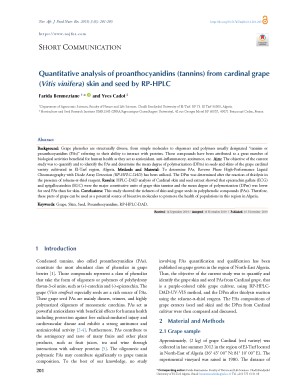Quantitative analysis of proanthocyanidins (tannins) from cardinal grape (Vitis vinifera) skin and seed by RP-HPLC
Abstract
Background: Grape phenolics are structurally diverse, from simple molecules to oligomers and polymers usually designated “tannins or proanthocyanidins (PAs)” referring to their ability to interact with proteins. Those compounds have been attributed to a great number of biological activities beneficial for human health as they act as antioxidant, anti-inflammatory, antitumor, etc. Aims: The objective of the current study was to quantify and to identify the PAs and determine the mean degree of polymerization (DPm) in seeds and skins of the grape cardinal variety cultivated in El-Tarf region, Algeria. Methods and Material: To determine PAs, Reverse Phase High-Performance Liquid Chromatography with Diode Array Detection (RP-HPLC-DAD) has been utilized. The DPm was determined after the reaction of thiolysis in the presence of toluene-α-thiol reagent. Results: HPLC-DAD analysis of Cardinal skin and seed extract showed that epicatechin gallate (ECG) and epigallocatechin (EGC) were the major constitutive units of grape skin tannins and the mean degree of polymerization (DPm) was lower for seed PAs than for skin. Conclusions: This study showed the richness of skin and grape seeds in polyphenolic compounds (PAs). Therefore, these parts of grape can be used as a potential source of bioactive molecules to promote the health of populations in this region in Algeria.
Full text article
Authors
Copyright (c) 2019 Authors

This work is licensed under a Creative Commons Attribution 4.0 International License.
-
Attribution — You must give appropriate credit, provide a link to the license, and indicate if changes were made. You may do so in any reasonable manner, but not in any way that suggests the licensor endorses you or your use.
-
No additional restrictions — You may not apply legal terms or technological measures that legally restrict others from doing anything the license permits.





